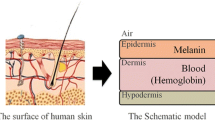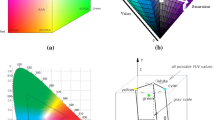Abstract
The conventional skin color separation method suffers from the severe limitation that the input skin image must have no shading component and must have substantial variation in the pigment density distribution, simultaneously. We therefore propose an improved method, which uses two input skin images instead of one. In this improved method, one input image has no shading component and the other has substantial variation in pigment density distribution. To verify the effect of our method, we took images of four subjects and separated them into pigment components. We then compared the independence evaluation value of the separated signals extracted using our method and that of the conventional method. The results show that we obtain separated signals that have a better independence evaluation value by our method than by the conventional method.














Similar content being viewed by others
References
Van Gemert MJC, Jacques SL, Sterenborg HJCM, Star WM (1989) Skin optics. IEEE Trans Biomed Eng 36(12):1146–1154
Anderson RR, Parrish JA (1981) The optics of human skin. J Investig Dermatol 77(1):13–19
Tsumura N, Haneishi H, Miyake Y (1999) Independent-component analysis of skin color image. J Opt Soc Am A Opt Image Sci Vis 16(9):2169–2176
Tsumura N et al (2003) Image-based skin color and texture analysis/synthesis by extracting hemoglobin and melanin information in the skin. In: ACM SIGGRAPH 2003 Pap.-SIGGRAPH’03, p 770, 2003
Fukunishi M, Kurita K, Yamamoto S, Tsumura N (2017) Non-contact video-based estimation of heart rate variability spectrogram from hemoglobin composition. Artif Life Robot 22(4):457–463
Mcduff D, Member S, Gontarek S, Picard RW (2014) Improvements in remote cardio-pulmonary measurement using a five band digital camera. IEEE Trans Biomed Eng 61(10):2593–2601
De Haan G, Jeanne V, De Haan G, Jeanne V (2013) Robust pulse-rate from chrominance-based rPPG. IEEE Trans Biomed Eng 60(10):2878–2886
Drew MS, Chen C, Hordley SD, Finlayson GD (2002) Sensor transforms for invariant image enhancement. Color Imaging Conf 2(1):325–330
Gilles B (1992) Blind separation of sources: a nonlinear neural algorithm. Neural Netw 5(6):937–947
Tanaka S, Kakinuma A, Kamijo N, Takahashi H, Tsumura N (2017) Auto white balance method using a pigmentation separation technique for human skin color. Opt Rev 24(1):17–26
Acknowledgements
We thank Edanz Group (http://www.edanzediting.com/ac) for editing a draft of this manuscript.
Author information
Authors and Affiliations
Corresponding author
Additional information
Publisher's Note
Springer Nature remains neutral with regard to jurisdictional claims in published maps and institutional affiliations.
About this article
Cite this article
Tanaka, S., Tsumura, N. Improved analysis for skin color separation based on independent component analysis. Artif Life Robotics 25, 159–166 (2020). https://doi.org/10.1007/s10015-019-00572-8
Received:
Accepted:
Published:
Issue Date:
DOI: https://doi.org/10.1007/s10015-019-00572-8




